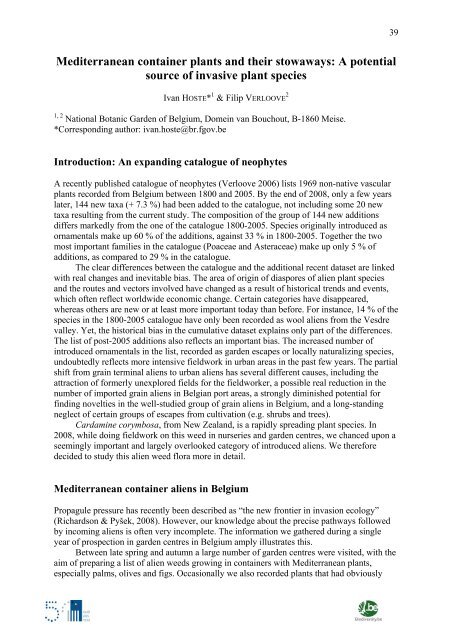Science Facing Aliens - Invasive Alien Species in Belgium - Belgian ...
Science Facing Aliens - Invasive Alien Species in Belgium - Belgian ...
Science Facing Aliens - Invasive Alien Species in Belgium - Belgian ...
Create successful ePaper yourself
Turn your PDF publications into a flip-book with our unique Google optimized e-Paper software.
Mediterranean conta<strong>in</strong>er plants and their stowaways: A potential<br />
source of <strong>in</strong>vasive plant species<br />
Ivan HOSTE* 1 & Filip VERLOOVE 2<br />
1, 2 National Botanic Garden of <strong>Belgium</strong>, Dome<strong>in</strong> van Bouchout, B-1860 Meise.<br />
*Correspond<strong>in</strong>g author: ivan.hoste@br.fgov.be<br />
Introduction: An expand<strong>in</strong>g catalogue of neophytes<br />
A recently published catalogue of neophytes (Verloove 2006) lists 1969 non-native vascular<br />
plants recorded from <strong>Belgium</strong> between 1800 and 2005. By the end of 2008, only a few years<br />
later, 144 new taxa (+ 7.3 %) had been added to the catalogue, not <strong>in</strong>clud<strong>in</strong>g some 20 new<br />
taxa result<strong>in</strong>g from the current study. The composition of the group of 144 new additions<br />
differs markedly from the one of the catalogue 1800-2005. <strong>Species</strong> orig<strong>in</strong>ally <strong>in</strong>troduced as<br />
ornamentals make up 60 % of the additions, aga<strong>in</strong>st 33 % <strong>in</strong> 1800-2005. Together the two<br />
most important families <strong>in</strong> the catalogue (Poaceae and Asteraceae) make up only 5 % of<br />
additions, as compared to 29 % <strong>in</strong> the catalogue.<br />
The clear differences between the catalogue and the additional recent dataset are l<strong>in</strong>ked<br />
with real changes and <strong>in</strong>evitable bias. The area of orig<strong>in</strong> of diaspores of alien plant species<br />
and the routes and vectors <strong>in</strong>volved have changed as a result of historical trends and events,<br />
which often reflect worldwide economic change. Certa<strong>in</strong> categories have disappeared,<br />
whereas others are new or at least more important today than before. For <strong>in</strong>stance, 14 % of the<br />
species <strong>in</strong> the 1800-2005 catalogue have only been recorded as wool aliens from the Vesdre<br />
valley. Yet, the historical bias <strong>in</strong> the cumulative dataset expla<strong>in</strong>s only part of the differences.<br />
The list of post-2005 additions also reflects an important bias. The <strong>in</strong>creased number of<br />
<strong>in</strong>troduced ornamentals <strong>in</strong> the list, recorded as garden escapes or locally naturaliz<strong>in</strong>g species,<br />
undoubtedly reflects more <strong>in</strong>tensive fieldwork <strong>in</strong> urban areas <strong>in</strong> the past few years. The partial<br />
shift from gra<strong>in</strong> term<strong>in</strong>al aliens to urban aliens has several different causes, <strong>in</strong>clud<strong>in</strong>g the<br />
attraction of formerly unexplored fields for the fieldworker, a possible real reduction <strong>in</strong> the<br />
number of imported gra<strong>in</strong> aliens <strong>in</strong> <strong>Belgian</strong> port areas, a strongly dim<strong>in</strong>ished potential for<br />
f<strong>in</strong>d<strong>in</strong>g novelties <strong>in</strong> the well-studied group of gra<strong>in</strong> aliens <strong>in</strong> <strong>Belgium</strong>, and a long-stand<strong>in</strong>g<br />
neglect of certa<strong>in</strong> groups of escapes from cultivation (e.g. shrubs and trees).<br />
Cardam<strong>in</strong>e corymbosa, from New Zealand, is a rapidly spread<strong>in</strong>g plant species. In<br />
2008, while do<strong>in</strong>g fieldwork on this weed <strong>in</strong> nurseries and garden centres, we chanced upon a<br />
seem<strong>in</strong>gly important and largely overlooked category of <strong>in</strong>troduced aliens. We therefore<br />
decided to study this alien weed flora more <strong>in</strong> detail.<br />
Mediterranean conta<strong>in</strong>er aliens <strong>in</strong> <strong>Belgium</strong><br />
Propagule pressure has recently been described as “the new frontier <strong>in</strong> <strong>in</strong>vasion ecology”<br />
(Richardson & Pyšek, 2008). However, our knowledge about the precise pathways followed<br />
by <strong>in</strong>com<strong>in</strong>g aliens is often very <strong>in</strong>complete. The <strong>in</strong>formation we gathered dur<strong>in</strong>g a s<strong>in</strong>gle<br />
year of prospection <strong>in</strong> garden centres <strong>in</strong> <strong>Belgium</strong> amply illustrates this.<br />
Between late spr<strong>in</strong>g and autumn a large number of garden centres were visited, with the<br />
aim of prepar<strong>in</strong>g a list of alien weeds grow<strong>in</strong>g <strong>in</strong> conta<strong>in</strong>ers with Mediterranean plants,<br />
especially palms, olives and figs. Occasionally we also recorded plants that had obviously<br />
39


